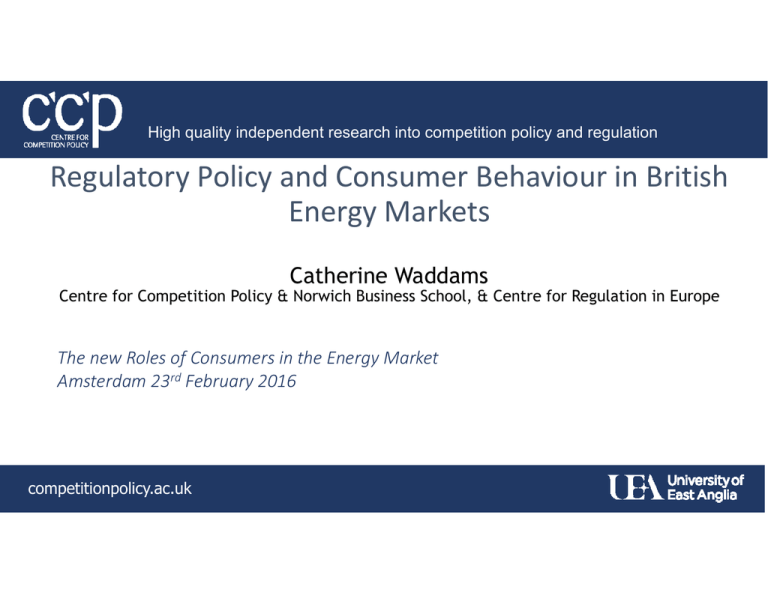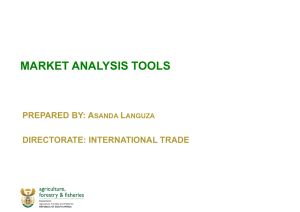Regulatory Policy and Consumer Behaviour in British Energy Markets Catherine Waddams The new Roles of Consumers in the Energy Market
advertisement

High quality independent research into competition policy and regulation Regulatory Policy and Consumer Behaviour in British Energy Markets Catherine Waddams Centre for Competition Policy & Norwich Business School, & Centre for Regulation in Europe The new Roles of Consumers in the Energy Market Amsterdam 23rd February 2016 competitionpolicy.ac.uk Regulatory Policy and Consumer Behaviour in British Energy Markets A. Regulatory policy 1. Non discrimination clauses 2008 2. Retail Market Review and limits to number of tariffs 2012 3. Referral to the Competition and Markets Authority 2014 B. Evidence of ‘behavioural’ consumers: errors of commission & omission C. Where next with CMA ‐ report mid 2016? D. Well functioning energy markets High quality independent research into competition policy and regulation A. Regulatory Policy 1. Non discrimination clauses (NDC) 2008 Companies charged more in areas where they were historical incumbent (inactive consumers stayed with them) than in areas where they were entrant (had to persuade consumers to switch away from another supplier who was incumbent in the area). High quality independent research into competition policy and regulation But despite these price differences, many consumers had not switched supplier So inactive consumers paid more. On grounds of ‘fairness’, Ofgem imposed non discrimination clauses High quality independent research into competition policy and regulation Concerns that non switchers were disproportionately ‘vulnerable’ Consumers who had never switched energy supplier Regulator introduced ‘no undue discrimination’ (NDC) clause in licenses (welcomed by consumer groups, challenged by ‘Big 6’ and ‘3 academics’) Prevents companies charging more (relative to costs) in home region, i.e. can no longer charge lower margins out of region High quality independent research into competition policy and regulation Increased tariffs and decreased consumer engagement Traditional view & Ofgem hope : NDCs would lower ‘in area’ and raise ‘out of area’ prices Profits (and prices) rose But because one company’s ‘strong’ market (home) is another’s ‘weak’ (entrant) market, ND is anti‐ competitive, prices rise (Hviid & Waddams Price 2012) Standard prices became more equal, less challenge from entrants (Waddams Price & Zhu, 2016) High quality independent research into competition policy and regulation Switching rates fell… …market segmented through increased special offers High quality independent research into competition policy and regulation 2. Retail Market Review and limits to number of tariffs 2012 “The large number of tariffs and their complexity discourage many from exploring alternative deals. Even the more active consumers can find it difficult to make the right choice.” (Ofgem 2012) “Limit each supplier to 4 tariffs per fuel, per meter and per payment type; …end … complicated multi‐tier tariffs, requiring all tariffs to be set out in a simple standing charge and unit rate structure; Require suppliers to give consumers more personalised information Introduce a Tariff Comparison Rate to allow comparison of tariffs across the market” But didn’t help much with switching rates; political pressure led to referral to CMA High quality independent research into competition policy and regulation A3. Referral to CMA: timing and statutory provisions Referred summer 2014 – 18 months extended to 2 years “…whether any feature, or combination of features, of each relevant market prevents, restricts or distorts competition in connection with the supply or acquisition of goods or services in the United Kingdom or a part of the United Kingdom. [if so] this constitutes an AEC [Adverse Effect on Competition]. But potential for Public Interest consideration: government can declare this at the beginning of investigation – did not do so in this case High quality independent research into competition policy and regulation Features (a) the structure of the market concerned… ; (b) any conduct …of one or more than one person who supplies or acquires goods or services; or (c) any conduct relating to the market concerned of customers of any person who supplies or acquires goods or services. If an ‘adverse finding’ need to consider remedies but not a blame game High quality independent research into competition policy and regulation Potential sources of competitive harm • which result in reduced rivalry (a) unilateral market power (including market concentration); (b) barriers to entry and expansion; (c) coordinated conduct; (d) vertical relationships; and (e) weak customer response. High quality independent research into competition policy and regulation 0 .2 Probability of switching .4 .6 .8 1 B. Behavioural consumers and switching: (Expected) Gain is the most consistent driver (1997, 2000, 2005, 2011 surveys) 0 100 200 300 Expected gain in £ High quality independent research into competition policy and regulation 400 500 Switching increases with potential savings, but levels off: decisions from a large collective switch, 2012 High quality independent research into competition policy and regulation Consumers differ in activity, largely because of expectations Groups determined by their general attitudes to buying 100 G1 G2 G3 Activity and expectations vary 90 1,2 80 1 G1 G2 G3 70 0,8 60 0,6 50 0,4 40 0,2 30 0 Big bargain hunter Gain/time Life too short Status quo Feel regret 20 ‐0,2 10 ‐0,4 ‐0,6 0 Searched ‐0,8 ‐1 High quality independent research into competition policy and regulation Switched Expected savings (£/year) Lower activity by older consumers explained by different expectations Expected Gains 18 16 Predicted probability of switching 14 12 10 8 6 4 2 0 Age 16‐24 25‐34 35‐44 45‐54 55‐59 60‐64 65‐74 75+ group High quality independent research into competition policy and regulation Choice may not always help: Collective switching participants less likely to switch with choice between two offers High quality independent research into competition policy and regulation Consumers often leave money on the table – Error of omission? Or evidence of searching/ switching costs (CMA, 2015) High quality independent research into competition policy and regulation Errors of commission: consumers make mistakes High quality independent research into competition policy and regulation C. Where next for the CMA ? Provisional Findings: Household (Domestic) Retail Market Provisional AEC from features of: • Weak consumer response • Supplier behaviour through segmentation • Regulations (non discrimination and retail market review) High quality independent research into competition policy and regulation Retail Remedies? If CMA finds an Adverse Effect on Competition, needs to consider remedies To remedy, mitigate or prevent the AEC or its detrimental effects on customers; capable of “effective implementation, monitoring and enforcement” Structural (vertical separation; splitting companies) – not proposed Regulatory related – less intervention by regulator – role of politics Consumer related: concern on understanding enough on ‘weak response’ – either what causes it, or how companies respond High quality independent research into competition policy and regulation Types of remedy for retail market (a) Remedies to provide a framework for effective competition between retail energy suppliers. (b) Remedies to facilitate widespread engagement by domestic and microbusiness customers. (c) Remedies to safeguard the interests of disengaged customers and encourage longer‐term engagement. How consistent are these? Eg temporary backstop regulated tariff as a maximum price to meet c) High quality independent research into competition policy and regulation Empowerment or protection? Need headroom (=profits) to attract entrants Are disengaged consumers expressing preference or disadvantage? More understanding needed For consumers, short term pain vs long term gain? UK experience discouraging? but are higher prices because of competition or regulatory intervention? Can we get the best (or worst?) of both worlds Is the decision economic or political? High quality independent research into competition policy and regulation What would a “Well functioning market” look like? • Homogeneous product • With entry costs If instantaneous and complete switching to cheapest • Compete price down to marginal cost • Cannot cover costs which are not marginal • Room for only one supplier • Back to (nationalised?) monopoly High quality independent research into competition policy and regulation Two statements/questions 1. Both the UK Competition and Markets Authority and the Council of European Energy Regulators have promoted the concept of “well functioning markets” What would these look like for retail energy? 2. What do we know about the ‘behaviour’ of different groups of consumers? What implications do any differences have for the equity of outcomes, for example if some groups of consumers find it much harder to engage with the market? High quality independent research into competition policy and regulation



